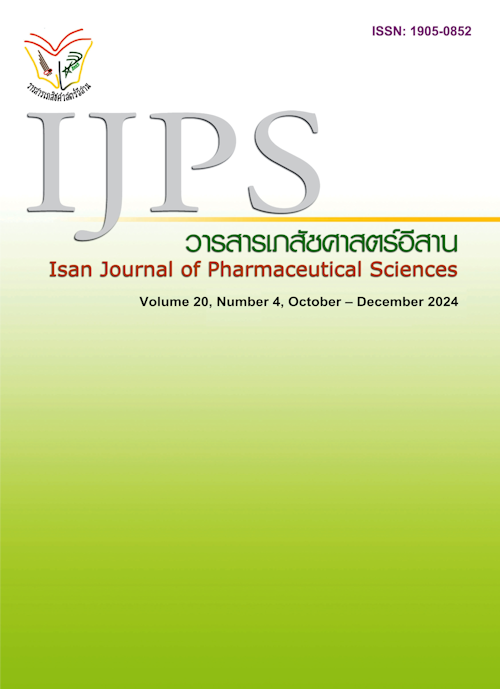ปริมาณและมูลค่าของการใช้ยาต้านแบคทีเรียในผู้ป่วยในโรงพยาบาลชุมชนแห่งหนึ่ง
Main Article Content
บทคัดย่อ
องค์การอนามัยโลกระบุว่าเชื้อแบคทีเรียมีการดื้อยาเพิ่มขึ้นอย่างต่อเนื่อง ในขณะที่ยาต้านแบคทีเรียมีประสิทธิภาพลดลง ส่งผลเพิ่มอัตราการเสียชีวิตและเพิ่มค่าใช้จ่ายในการรักษา การติดตามและควบคุมการใช้ยาต้านแบคทีเรียในระดับโรงพยาบาลเป็นอีกวิธีการที่สำคัญในการป้องกันและควบคุมการแพร่กระจายของเชื้อดื้อยาอย่างมีประสิทธิภาพ วัตถุประสงค์: เพื่อวิเคราะห์หามูลค่าและปริมาณการใช้ยาต้านแบคทีเรียชนิดฉีดในรูปแบบ Defined Daily Dose (DDD) แยกตามรายการและกลุ่มยาที่มีในโรงพยาบาลจัตุรัส ระหว่างวันที่ 1 ตุลาคม 2564 – 30 กันยายน 2566 วิธีการศึกษา: วิจัยเชิงพรรณนาสืบค้นข้อมูลการสั่งใช้ยาต้านแบคทีเรียชนิดฉีดในผู้ป่วยในของโรงพยาบาลจัตุรัสจากฐานข้อมูล HOSxP และโปรแกรม RDUR9 version 63.01.01 เขตสุขภาพที่ 9 เพื่อวิเคราะห์หาค่า DDD และคำนวณมูลค่าการสั่งใช้จากราคาที่จัดซื้อในแต่ละปี วิเคราะห์ข้อมูลโดยใช้สถิติเชิงพรรณนาและการถดถอยเชิงเส้นอย่างง่าย (simple linear regression) ผลการวิจัย: พบว่าในระหว่างปีงบประมาณ 2564-2566 มีมูลค่าการใช้ยาต้านแบคทีเรียชนิดฉีดรวม 2,992,767บาท โดยในแต่ละปีงบประมาณมีมูลค่าเท่ากับ 907,482 บาท 887,663 บาท และ 1,197,622 บาท ตามลำดับ ทั้งนี้การใช้ยาต้านแบคทีเรียชนิดฉีดมีมูลค่าสูงขึ้นเฉลี่ยร้อยละ 14.54 ต่อปี เมื่อพิจารณาปริมาณการใช้ยาต้านแบคทีเรียชนิดฉีดแยกตามกลุ่มยารวมทั้ง 3 ปีงบประมาณ พบว่ากลุ่มยาต้านแบคทีเรียชนิดฉีดที่มีปริมาณการใช้สูงสุด 3 อันดับแรก ได้แก่ third-generation cephalosporins , lincosamides และ nitroimidazoles ตามลำดับ มูลค่าการใช้ยาต้านแบคทีเรียชนิดฉีดรวม 3 ปีงบประมาณแยกตามรายการยา พบว่ารายการที่มีมูลค่าการใช้สูงสุด 3 อันดับแรก ได้แก่ meropenem, ceftazidime และ ceftriaxone เท่ากับ 671,797 บาท 562,080 บาท และ 440,217 บาท ตามลำดับ คิดเป็นร้อยละ 22.45, 17.58 และ 14.71 ของมูลค่าการใช้ยาต้านแบคทีเรียชนิดฉีดรวมทั้งหมด ตามลำดับ ส่วนปริมาณการใช้ยาต้านแบคทีเรียชนิดฉีดในหน่วย DDD ช่วงปีงบประมาณ 2564 - 2566 แยกรายชนิดยาสูงสุด 3 อันดับแรก ได้แก่ ceftriaxone, clindamycin และ ceftazidime เท่ากับ 43.77, 16.34 และ 11.32 ตามลำดับ สรุปผลการวิจัย: ปีงบประมาณ 2564-2566 โรงพยาบาลจัตุรัสมีมูลค่าการสั่งใช้ยาต้านแบคทีเรียชนิดฉีดเพิ่มขึ้นเฉลี่ยร้อยละ 14.54 ต่อปี ปริมาณการสั่งใช้ยาต้านแบคทีเรียชนิดฉีดในหน่วย DDD มีแนวโน้มเพิ่มขึ้นเฉลี่ยร้อยละ 24.20 ต่อปี
Article Details

This work is licensed under a Creative Commons Attribution-NonCommercial-NoDerivatives 4.0 International License.
กรณีที่ใช้บางส่วนจากผลงานของผู้อื่น ผู้นิพนธ์ต้อง ยืนยันว่าได้รับการอนุญาต (permission) ให้ใช้ผลงานบางส่วนจากผู้นิพนธ์ต้นฉบับ (Original author) เรียบร้อยแล้ว และต้องแนบเอกสารหลักฐาน ว่าได้รับการอนุญาต (permission) ประกอบมาด้วย
References
Bansal D, Mangla S, Undela K, et al. Measurement of adult antimicrobial drug use in tertiary care hospital using defined daily dose and days of therapy. Indian J Pharm Sci. 2014;76(3):211-7.
Chaiyasong C, Tiyapak P, Pinake S, et al.Associations between antibiotics use and resistance in Mahasarakham hospital. Isan J Pharm Sci. 2019;15(2)98-105.
Junkunapas P, Bunyarit P, Prapasone N, et al. AMR hospital management guideline. Nonthaburi: Health Administration Division; 2016.
Khoka A. Antibiotics and antibiotic resistance. J Med Health Sci. 2020; 27(2): 125-139.
Muller A, Monnet DL, Talon D, et al. Discrepancies between prescribed daily doses and WHO defined daily doses of antibacterials at a university hospital. Br J Clin Pharmacol. 2006;61(5):585-91.
Phumart P, Phodha T, Thamlikitkul V, et al. Health and economic impacts of antimicrobial resistant infections in Thailand: a preliminary study. J Health Sys Res. 2012;6(3):353-60.
Pitayatienanan P, Dejkong S, Chaweerak J. Quaility and value of injectable antibacterial drugs prescribed at in-patient department of Rajavithi hospital. J DMS. 2021;46(1):117-26.
Singh P, Gupta DK, Bindra A, et al. Antimicrobial consumption in intensive care unit patients at level 1 trauma centre in India. Indian J Med Microbiol. 2022;40(1):86-90.
Sözen H, Gönen I, Sözen A, et al. Application of ATC/DDD methodology to evaluate of antibiotic use in a general hospital in Turkey. Ann Clin Microbiol Antimicrob. 2013;12:23.
Surinrach A, Kerdsin A, Somsri P. Risk factors of carbapenem-resistant bacteria infection in stroke patients at Sakon Nakhon hospital. J Sakon Nak Hosp. 2019;22(1):40-51.
Tarun S, Kapil S, Amit N, et al. Assessment of antimicrobial drugs utilization in tertiary care hospital - an antimicrobial stewardship implication. Int J Health Sci. 2022;6(S7):5474–83. Available from:https://sciencescholar.us/journal/index.php/ijhs/article/view/13258
WHO Collaborating Centre for Drug Statistics Methodology. Guidelines for ATC classification and DDD assignment 2024 [Internet]. Oslo, Norway: World Health Organization; 2024 [cited 2024 Jan 10]. Available from: https://www.whocc.no/atc_ddd_index_and_guidelines/guidelines/
Yooyong S, Phumiruttanaprapin S. Amount of prescribing of injectable antibacterial drugs in defined daily dose(ddd) in inpatients at Chaiyaphum hospital. Thai J Clin Pharm. 2023 ;29(1):1-12.

